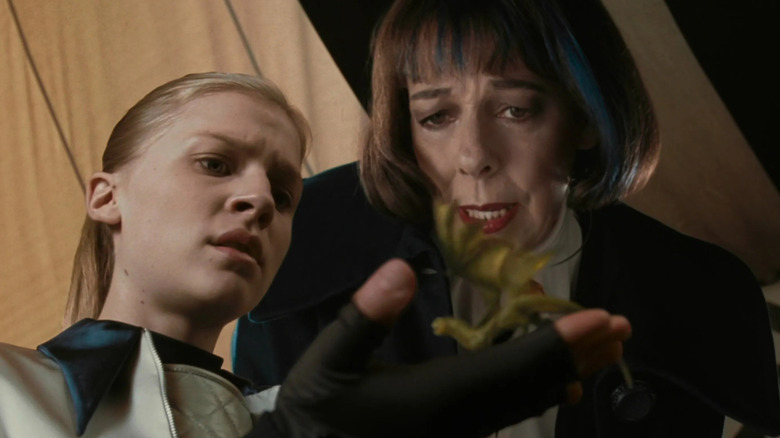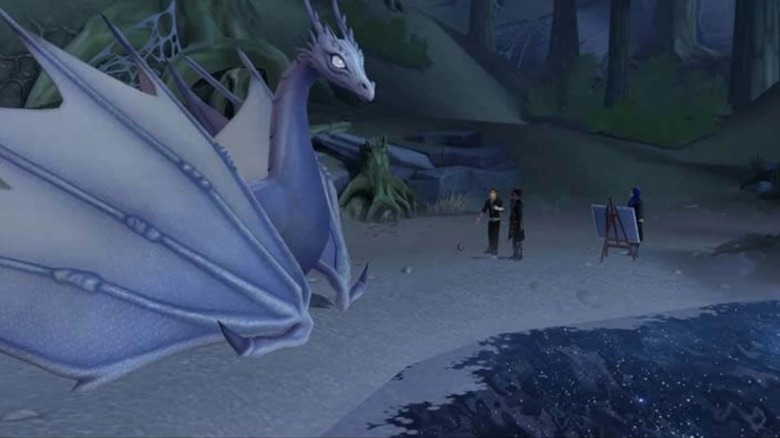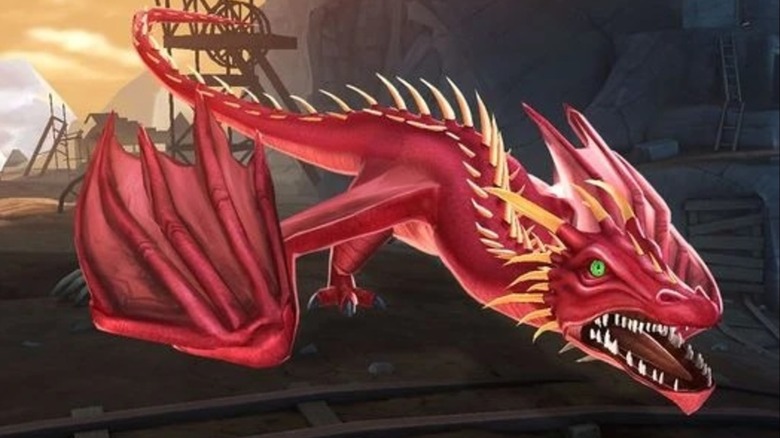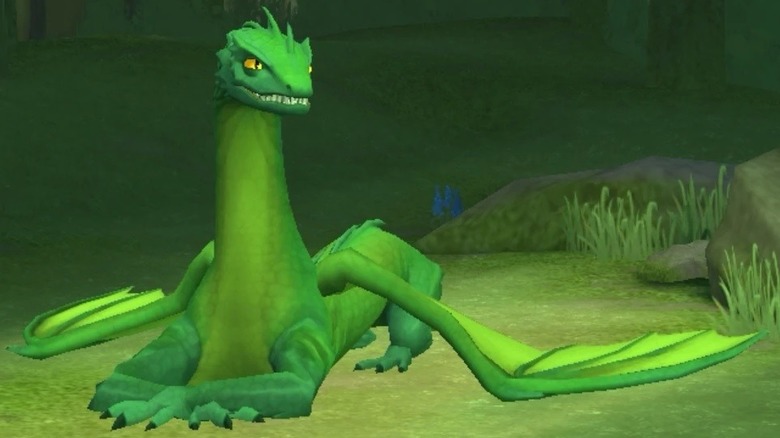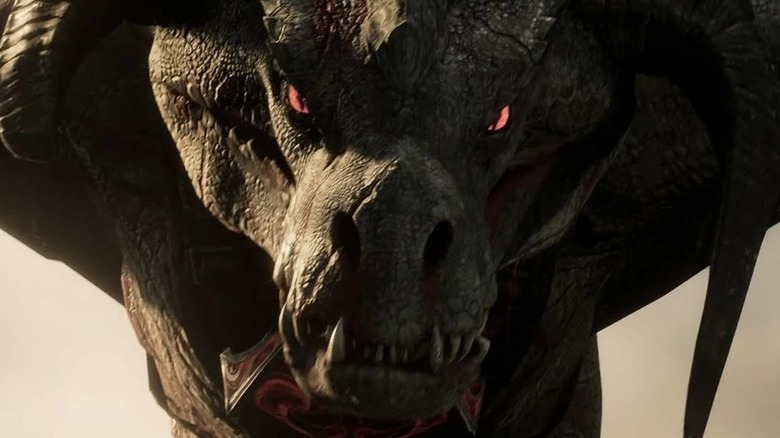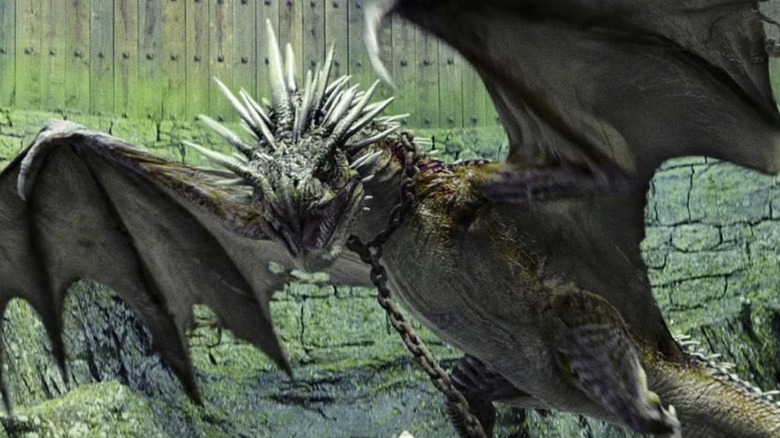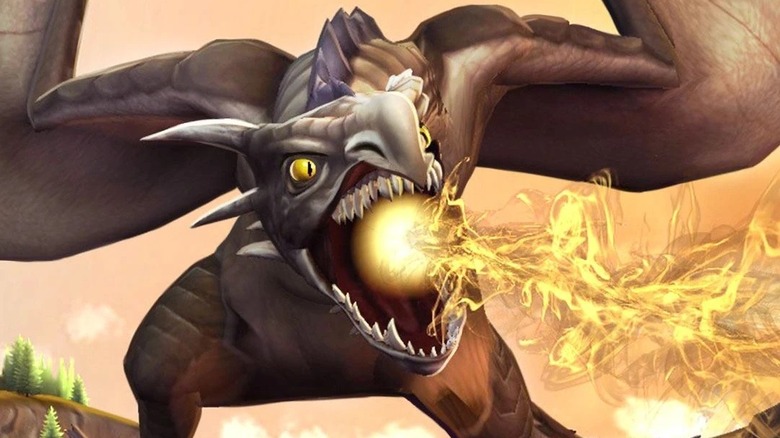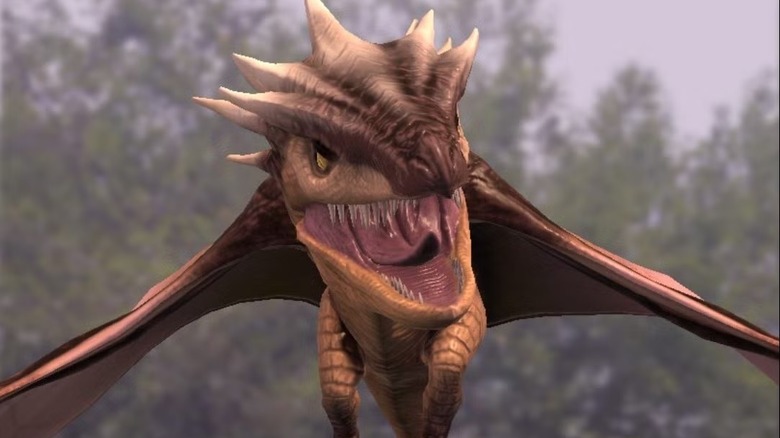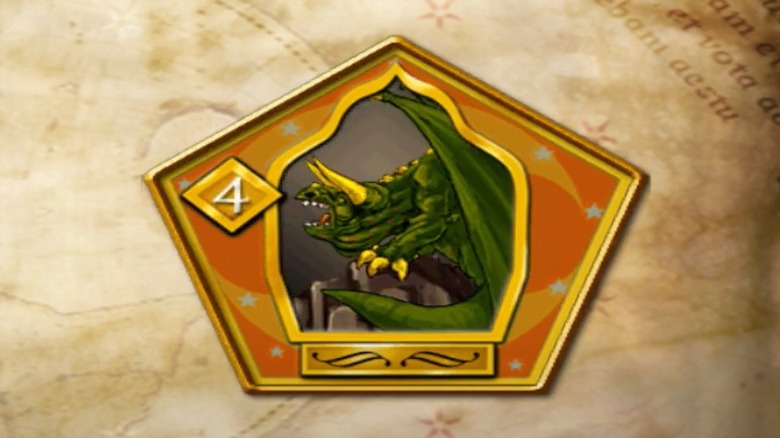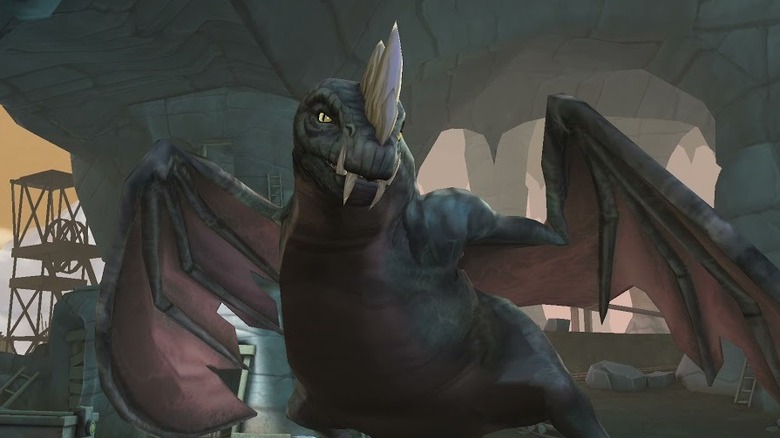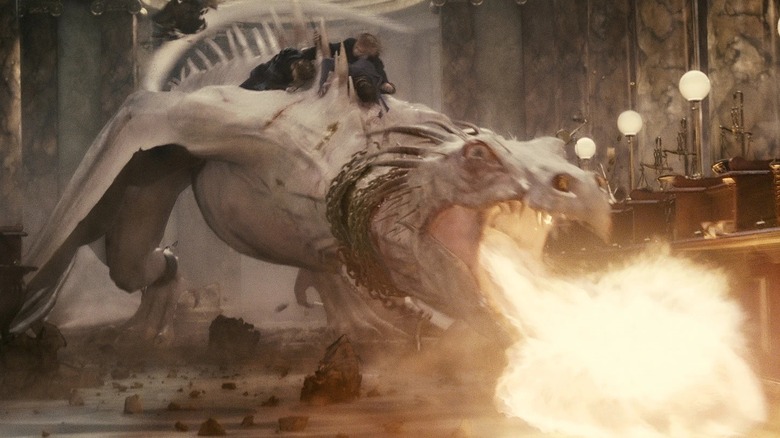Every Dragon Breed In The Harry Potter Universe Explained
Of all the magical creatures Harry Potter is introduced to during his time at Hogwarts, dragons are definitely among the most dangerous. The Boy Who Lived actually gets to see a dragon hatching during a visit to Hagrid's hut in his first year, and he later experiences just how fierce they can be when he faces off against one during the Triwizard Tournament.
In the wizarding world, the Ministry of Magic classifies magical creatures on a rating scale from one X to five Xs based on danger and ease of handling. Dragons are rated as XXXXX by the government, meaning the flying reptiles can't be domesticated (despite Hagrid's best efforts) and are known wizard killers. However, these creatures are important to wizarding society, from the twelve uses of dragon blood discovered by Albus Dumbledore to the use of dragon heartstring as a wand core.
Those who have read the supplemental book "Fantastic Beasts and Where to Find Them" will know that there are many more dragon breeds than the ones Harry encounters during his time at Hogwarts. From a small dragon found in South America to one known for carrying a ship out of the Black Sea, here is everything you need to know about all the dragon breeds in the "Harry Potter" franchise.
Antipodean Opaleye
The Antipodean Opaleye is easily the prettiest dragon in the wizarding world. Native to New Zealand, it is covered in iridescent scales, giving it a pearl-like shimmer. Much like the gem the opal, the dragon's eyes are usually multicolored, and it has no visible pupils. In contrast to the light color of its body, when it breathes fire, the flame is a bright red. It isn't the largest type of dragon, with its average weight of two-to-three tons making it medium-sized when compared to other species. Muggles who stumble upon its egg shells might think they are fossils because of the egg's light gray color.
Though native to New Zealand, Opaleyes do migrate to Australia at times. They prefer to live in valleys rather than mountains like other dragons, which might make them more visible to humans than most species. Never fear, though — it isn't considered an aggressive dragon by any means. While they prefer to eat sheep and other similarly sized animals, in the 1970s, a male Antipodean Opaleye killed a group of kangaroos. Magizoologists believe this happened after the male was ousted from its territory by a female Opaleye, the dominant gender with this species.
In the now defunct game "Harry Potter: Magic Awakened," Hagrid and Charlie Weasley take care of an ill Opaleye. It is one of several sick dragons in the game.
Chinese Fireball
The Chinese Fireball, also known as the Liondragon, is a bright red, aggressive dragon native to China. The name "fireball" comes from the shape its fire takes as it comes out of its nose: it resembles a mushroom cloud. It is also known for the golden spikes on its face. This dragon species is medium-sized, weighing between two and four tons on average. Its eggs, which are bright red and flecked with gold, are considered valuable to Chinese wizards. Though aggressive, this dragon is willing to share territory with other Fireballs, but you'll rarely find more than two or three dragons per area. People should beware because the species is known to eat humans, though it tends to go after pigs.
During the first task of the Triwizard Tournament, Durmstrang's Viktor Krum, the famous Bulgarian Quidditch player who made a connection with Hermione, faces off against a Chinese Fireball. While he loses points because the dragon crushes the other eggs during the task, Krum utilizes the Conjunctivitis Curse to cause temporary blindness in the creature so he can snag the golden egg he needs to complete the challenge.
In the mobile game "Harry Potter: Hogwarts Mystery," students learn about Sir Elric Parpidum, a dragon killer who once dueled with a Chinese Fireball. He was also an avid collector of dragon claws, which he stored at Gringotts.
Common Welsh Green
The Common Welsh Green is one of the most recognizable dragons because of its green color, but it goes out of its way to avoid humans. It lives high up in the mountains of Wales, blending in well with the greenery. Even if you can't see a Common Welsh Green that's nearby, once you hear its roar, you'll know: This dragon's roar is more musical sounding compared to other dragons. Hikers should watch where they step, as the eggs of a Common Welsh Green are brown with green specks, meaning they may blend in with the ground.
While the Common Welsh Green typically steers clear of humans, it is the dragon behind one of the most well-known dragon-related incidents in wizarding history. In 1932, sunbathers in Ilfracombe, England got the surprise of a lifetime when a Welsh Green appeared and proceeded to attack those on the beach. Thankfully, a wizarding family by the name Toke was vacationing there and they were able to handle the creature. Because of the severity of the incident and the number of Muggles involved, the family cast group Memory Charms to preserve the secrecy of the wizarding world. The Tokes were awarded the Order of Merlin, First Class for how they handled the situation and for casting one of the biggest Memory Charms of all time.
The Common Welsh Green is one of the four dragons used in the first task of the Triwizard Tournament. Beauxbatons Academy of Magic's champion Fleur Delacour battles the dragon, using spells to force it into a sleepy stupor. However, the charm is not entirely effective, as the dragon wakes up while she is taking the golden egg. Thankfully, she makes it out unharmed.
Hebridean Black
The Hebridean Black is a species of dragon native to the Hebrides archipelago of Scotland. It is dark in color with bright eyes, sharp ridges along its back, and a spike shaped like an arrow at the end of its tail. It is a larger dragon, growing up to 30 feet. Hebridean Blacks are polar opposites to Common Welsh Greens, the other dragon native to the United Kingdom. This dragon species is much more aggressive, which makes the Hebrides the perfect spot for the population — only a few of the region's many islands are inhabited by humans.
Unlike other dragons, a single wizarding family has taken responsibility for them. Because Hebridean Blacks only live in the Hebrides archipelago, the MacFusty family watches over the group and ensures the dragons don't do anything that could break the International Statute of Secrecy. This type of dragon typically eats deer, but it has been known to snag cows, sheep, and dogs from the area, which is probably what the MacFustys are trying to prevent. Quidditch fans might also know that the Hebridean Black is the dragon species the Banchory Bangers (a notoriously bad Scottish Quidditch team) tried to catch so it could be their mascot.
In the video game "Hogwarts Legacy," a Hebridean Black attacked Hogwarts on the first day of school in 1890. The dragon was under the direction of a goblin named Ranrok and was meant to go after visiting Ministry of Magic official George Osric and Magical Theory professor Eleazar Fig.
Hungarian Horntail
The Hungarian Horntail is a black dragon with bright yellow eyes and bronze spikes on its head and tail. It looks more like a lizard compared to the other dragon species, and is considered the most dangerous of the dragons. With eyes that look cat-like and flames that can reach up to 50 feet in front of them, it's best to keep your distance from this type of dragon. Its eggs are dark gray with hard shells, likely to ensure they don't melt from the high temperatures of the Horntail's fire. While Horntails tend to feed on livestock, this dragon won't turn its nose up at humans.
The Hungarian Horntail is the dragon Harry Potter faces in the Triwizard Tournament as one of the two Hogwarts champions. While known as the most aggressive of the dragon species, that aggression grows as they protect their young, making Harry's task particularly dangerous and brutal. Harry is able to lead the dragon away from the task area by flying on his broom, eventually looping back to grab the golden egg from the nest, much like he would the Golden Snitch during a Quidditch game. The scene shows the dragon's ferocity and how fast it can fly.
In the game "Harry Potter: Hogwarts Mystery," a Hungarian Horntail guards one of the Cursed Vaults that players have to break into. The following school year, a Horntail mistakes a goblin-made egg for one of its own, stealing it and taking it to the Romanian Dragon Sanctuary.
Norwegian Ridgeback
The Norwegian Ridgeback is native to Norway, living in the more mountainous regions. They are similar in appearance to Hungarian Horntails, but they have a more brownish tint to their scales and their tail spikes are black instead of bronze. The Ridgeback is one of two dragon species to have venomous fangs, making it incredibly dangerous. It's also one of the rarer dragons. What's interesting about Ridgebacks is that they tend to target aquatic animals for food as opposed to just land mammals. There is a report from 1802 of one carrying off a whale calf, but the details in the report can't be confirmed. This dragon's eggs are black, making them darker than a Horntail's, and baby Ridgebacks typically learn to use their flames earlier than other species.
During Harry's first year at Hogwarts, Rubeus Hagrid, the school's gameskeeper and Harry's first contact with the wizarding world, wins a Ridgeback egg during a game of cards, eventually hatching it in his home and naming it Norbert. With the help of Ron Weasley's brother Charlie, who works at the Romanian Dragon Sanctuary, the baby dragon is moved to the sanctuary and later renamed Norberta when the keepers learn that it's a female dragon. Hagrid may have been able to get away with owning the dragon for a touch longer if it weren't for Draco Malfoy, who discovers it while spying on Harry, causing Hagrid to need to rehome the baby sooner rather than later. Though, to be fair, it was probably for the best — even as a baby, it was able to singe Hagrid's beard with its flames.
Peruvian Vipertooth
The Peruvian Vipertooth is the smallest of the dragon species, averaging about 15 feet in length. It has short horns and black ridges along its back. This dragon is copper colored and, like the Norwegian Ridgeback, has venomous fangs. Don't let its size fool you: While it likes to eat cows and goats just as much as the next dragon, this species also likes humans. It is the fastest flyer among the dragons, too, meaning you won't be able to outrun it. Harvey Ridgebit, a dragonologist, is credited as the first wizard to catch this type of dragon.
The Vipertooth had to undergo population control by the International Confederation of Wizards in the nineteenth century. The species was reproducing in incredibly large numbers and, because of how much they like to eat humans, wizards were forced to step in. This made sure the International Statute of Secrecy wasn't broken and probably saved quite a few humans from becoming a dragon's meal.
The wizarding disease Dragon Pox is also believed to have originated from Peruvian Vipertooths. It's thought that it jumped from the dragons to the wizards working with them and then started to spread among wizarding populations. The pox is fatal and involves symptoms like a green tinge to the skin, sparks originating from the nose, and a rash between toes.
Romanian Longhorn
Romanian Longhorns are a dark green dragon native to Romania, specifically living in the Carpathian mountains. Like the species name suggests, it has long horns, which are gold in color, and uses them to stab its prey. It usually goes after the land mammals in its area. The Carpathian mountains are home to the largest dragon reserve and sanctuary in the world: the Romanian Dragon Sanctuary. In addition to Longhorns, all species of dragons are there for wizards to study and the sanctuary is where dragons who need to be relocated (like Hagrid's Norwegian Ridgeback) are kept. It provides a safe environment for the research and protection of dragons.
Romanian Longhorns in particular are at risk of poaching because of their horns. In a powdered form, it can be used in potions, which has caused people to seek out the dragons to take their horns. To deter this, its horn has been made a Class B Tradeable Material, meaning that while it can legally be traded, there are significant restrictions in place. This is in addition to all dragon eggs being considered a Class A Tradeable Material. Longhorn numbers continued to decrease due to poaching, which caused the development of a breeding program and the sanctuary to help increase its population.
Swedish Short-Snout
The Swedish Short-Snout is known for its bluish-silver scales and short snout. Its skin has been used to make protective shields and gloves. This dragon species prefers to live as deep into the mountains as it can go. The Short-Snout's flame is bright blue and incredibly hot, making something a pile of ash within a few seconds. While it is not known for killing humans like several other types of dragons, that is speculated to be because it resides far away from human populations.
The Swedish Short-Snout is one of the four dragon species used in the first task of the Triwizard Tournament. Hufflepuff Cedric Diggory, one of two Hogwarts champions alongside Harry, tried to distract the dragon by transfiguring a rock into a dog, causing it to move away from the nest. While he was able to grab the golden egg, the dragon did burn him after it turned its attention back to its nest in the middle of Cedric's efforts. The burns required medical attention from Madam Pomfrey.
There is a Swedish dragon sanctuary that broom racers fly through during an annual broom race between Kopparberg and Arjeplog. The winner of the race receives a trophy that has the likeness of the Short-Snout.
Ukrainian Ironbelly
Ukrainian Ironbellies are native to Ukraine and are the largest dragon species in the wizarding world. This dragon can weigh up to six tons and will crush anything it lands on, including buildings. It also has long talons, adding to its scary nature. While its weight and size does make this dragon species a slower flier, it doesn't make it any less dangerous.
The wizarding government in Ukraine is constantly watching the Ironbellies because, in 1799, one carried off an entire ship. Though the boat was empty, it posed an issue with the International Statute of Secrecy and is not an event the authorities want to see repeated. In "Hogwarts Legacy," Auror Helen Thistlewood had to stop an Ironbelly that was released on a Muggle town sometime during the 1800s. Magizoologist Newt Scamander worked with this dragon species during World War I.
When Harry, Ron, and Hermione try to break into the Lestrange family vault at Gringotts during "Harry Potter and the Deathly Hallows," a malnourished Ukrainian Ironbelly is guarding several of the older vaults. It is subdued by the goblins with a set of clankers, which cause the dragon to back off as it associates the sound with pain. The trio use the dragon to escape the bank, riding it to a lake before jumping off.
